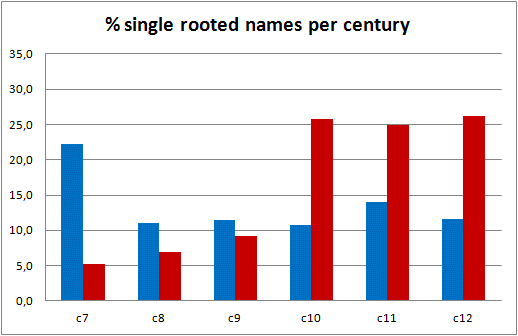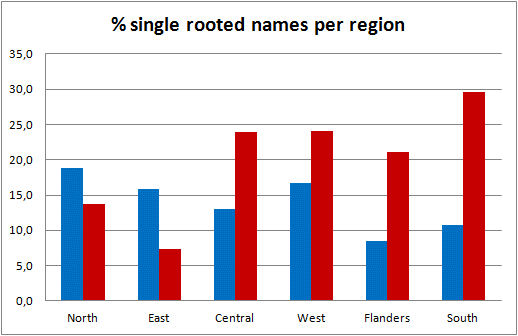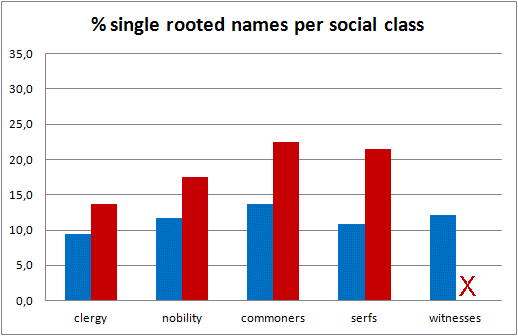Most Germanic names consisted of two elements. However, sometimes one of the two elements was abbreviated, or an element could even disappear completely. Usually this was the second part, but the first part could also de dropped.
Furthermore, there were Germanic names which originally consisted of just one element (such as Brun and Ernst). Shortened bipartite names and originally singular names were hard to distinguish, and both have been considered single rooted names here.
In the present study almost 800 persons with a single rooted (or singular) name were found.

Figure 1. Percentage single rooted Germanic names per century for men (blue) and women (red).

Figure 2. Percentage single rooted Germanic names per region for men (blue) and women (red).

Figure 3. Percentage single rooted Germanic names per social class for men (blue) and women (red).
One in every eight men had a single rooted Germanic name (12,4%).
Over time, no increasing or decreasing trend could be discerned.
The differences between the regions among the men were statistically significant, with low scores in Flanders and the South and high scores in the North and West.
Also between the social classes the differences were significant: among clerics single rooted names were relatively rare, while the other classes did not differ much.
(1)
Single rooted names occurred considerably more frequent among women than among men: 21,5% versus 12,4%.
This difference only appeared halfway the study period: in the 7th, 8th and 9th century the percentages among the women were below 10%, and thereafter they rose to more than 25%.
When looking at single rooted women’s names in the various regions, the low scores in the regions North and especially East catch the eye. This can be explained by the fact that here (in comparison with the other regions) relatively many women were registered in the early centuries, when single rooted names were relatively uncommon. After the 9th century the scores in these same regions (based on small numbers) were about 20%, which differed little from the other regions.
Among women there were no striking differences between the social classes.
(2)
With regard to single rooted names, the difference between men and women and the sudden increase among women were the most remarkable patterns. Due to the low numbers, no conclusions could be drawn regarding the possible influence of social class and regional differences.
In his study of Flemish names, Leys concluded that there was no gender difference regarding the frequency of single rooted (singular) names. For women he found 23% short names (70 of 300) and for men 18% (420 of 2350).
(3)
Leys qualified these percentages as ‘practically equal’, but the difference did reach statistical significance.
(4)
The numbers presented by Leys are remarkable. His score for women is comparable with the score for Flemish women in the present compilation, but for men he came up with a much higher percentage.
Leys based his observations on a charter book also used here: the Diplomata Belgica.
(5)
This collection (the 'DB') contains a lot of Flemish material and also charters from other regions (St-Truiden, Utrecht, Holland, Gelderland, Maastricht). In his comparison, Leys considered only the Flemish women, and all men (including those not from Flanders).
In the DB, he counted 420 single rooted male names (on a total of about 2350). However, when running through the index of the DB, I cannot count more than 211 (on a total of indeed about 2350). There may be a disagreement on the interpretation of some particular cases, and sometimes it may have been uncertain whether a name referred to a man or a women. However, this cannot explain the large difference in the counts. It looks like Leys has made a miscalculation somewhere.
Anyway, from the list of names it should be clear that little can be said against the percentages of singular names calculated here. The conclusion remains, that single rooted names were more frequent among women than among men, especially in Flanders.
In Scandinavia women had predominantly single rooted names.
(6)
In early-medieval England, single rooted occurred mostly among slaves.
(7)
This pattern is not corroborated by the present study.
Notes
1 - Difference between the regions regarding single rooted Germanic names among men: X²=67,75, df=5, p<0,001. The region Frisia has been excluded from this analysis, due to the low numbers; this region scored high, just like the regions North and West (17,6%).
Difference between the social classes among men: X²=12,60, df=5, p<0,05.
2 - Difference between the regions among women: X²= 11,61; df=5; p<0,05 (without the region Frisia).
Difference between the social classes among women: X²= 2,70, df=4, NS (without the class 'witnesses').
3 - Leys (1959, p. 14).
4 - X²=5,96, df=1, p<0,02.
5 - Gysseling & Koch, Diplomata Belgica (1950).
6 - Woolf (1940, cited in Leys, 1959, p. 13).
7 - Redin (1919, cited in Leys, 1959, p. 14).
|



